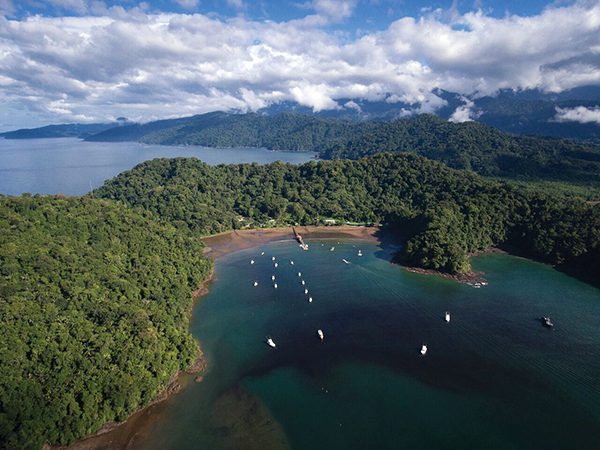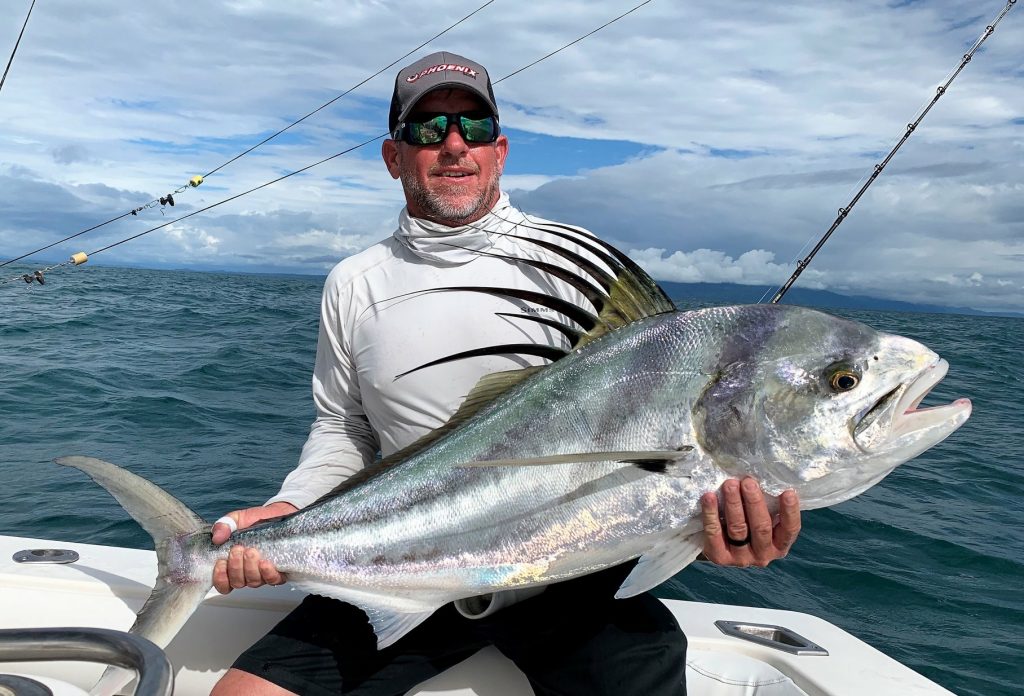
David Fremont with a net full of lively shrimp. Boyd’s One Stop is located at the base of the Texas City Dike and provides bait, tackle, advice and seafood to its patrons. You can find David behind the counter, helping customers or out on the Dike taking pictures for the Texas City Dike Fishing Group.
David Fremont of Boyd’s One Stop, and Admin of the popular Texas City Dike Fishing Group talks history, Texas City fishing and Boyd’s big plans for the future.
Interview by Brandon Rowan
Where are you from? Tell me about your background and how fishing became an important part of your life.
I was born on Galveston Island in 1954. My daddy worked for Amoco Oil in Texas City and moved us over here when I was a year old. I grew up a street off Bay Street, which is walking distance from the Texas City Dike. I went to work at Boyd’s when I was 14 years old, and I was one of the first kids to go to work with Gene Boyd, the original owner. He was an outboard shrimper and lived across the street from us.
He came over one day and he says “Hey you want to go to work for me? I’m going to open up that old Surfside restaurant on the Dike and have a bait camp. I’ll pay you a dollar an hour and I’ll work you to death!”
Well a dollar an hour was like hitting the lottery for me back then so I jumped on it. But he didn’t lie; he paid me but he also expected an awful lot and also taught me a whole bunch about dealing with the public. He made it perfectly clear that the customers were his bread and butter and I was a necessary evil. But he was tough, fair and just a great guy.
I stayed with Boyd’s until I went off to the local college and then worked for Amoco, like my dad did, and I spent 35 years there. I never quit coming to the Dike and fishing and having a good time.
How did the very popular Texas City Dike Fishing Group get its start?
After I retired, Jason Cogburn, the current owner of Boyd’s One Stop, asked me if I’d like to come help with some of the advertising and social media. I didn’t know too much about it all at first, but we had a little text group that we started with. Now Boyd’s has built up its Facebook followers to about 63,000 and the text group is still active. Like, this last week we just sent one out to about 25,000 people when we had crawfish on sale.
The Texas City Dike Fishing Group started out before Facebook. There was a handful of us old timers that would meet up and fish on the Dike regularly. We started using a real primitive fishing group on the internet as a way to keep in touch when we weren’t out there fishing together. We’d share stories and how fishing was going and such.
Then when Facebook took over, we were able to migrate to that platform with our same handful of guys. I started incorporating it with Boyd’s when people would come in and want to know what was going on with the fishing scene on the Dike. I would say “Well get on my little Texas City Dike Fishing Group! We’ll add you to it and you’ll see what the latest and the greatest is on what’s being caught.”
And in no time, it just kept growing and growing and now we’ve got over 15,000 people involved. Now I can keep people informed on what’s going on and what’s happening with Boyd’s, in terms of bait and fishing tournaments. This past season, our flounder tournament had 425 people in it. We were able to give away over $8,000 as we do 100% payout.
I know you guys have had some real trophy fish brought in during your flounder tournaments.
We have! We’ve had some real good catches. This past flounder run for the Dike was a little on the slow side but that’s just mother nature. Sometimes those flounder will migrate different ways and in larger numbers. The Galveston Channel still had plenty of fish to be caught. I was over there a time or two and had some good days. Some of our regular fishermen, like Jantzen Miller, also known as the flounder guru, is a great guy and won the tournament in 2017. He tags flounder and he keeps me, and many others, informed about what the flounder are doing. He fishes a lot and caught a couple ten pounders late last summer and early fall.

Boyd’s 2019 Drumathon tournament runs until April 15. It is a $20 entry fee and 100% payout for the winners. Visit www.boydsonestop.com to register.
What’s the word on the Boyd’s Drumathon Tournament?
We haven’t done one in a couple years but a lot of guys said “Hey the flounder run is over, let’s play drum!” So that’s what we did! It kicked off in February and will go until April 15. There are categories for slot and oversized drum. It’s $20 to sign up at Boyd’s or online at www.boydsonestop.com and has a 100% payout. Last I checked, we already have 125 people signed up.
Tell me more about Boyd’s owner Jason Cogburn and some of the big things he has in the works.
Jason Cogburn worked here as a bait boy many years ago and was fortunate, in that he was able to purchase the place. It had been bought and sold a few times after Gene Boyd passed away. Jason has turned it into a very nice business. He’s a family man and a man of great faith. He has started working with crawfish and it has taken over a big part of the operation. We are still very much involved with bait and tackle, but the crawfish business eats up 5 or 6 months of the year and it keeps us busy.
We just recently finished construction on our 30,000 sq. ft. crawfish and seafood facility behind Boyd’s. We are still setting it all up but that’s where we’ll bag and process our live Louisiana crawfish. Currently, we sell quite a bit of wholesale seafood to the H-E-B chain of grocery stores. We are very involved with them and ship an awful lot of crawfish to their San Antonio hub. They distribute to the stores near there and we deliver direct to many of the Houston area H-E-B locations. This also includes some large table shrimp and quite a few blue crab.
Once the processing facility is up and running and in good shape, our next phase is to build a new Boyd’s storefront, similar to a ‘mini Bucees.’ This would also include a huge tackle area and a large variety of bait, more than what we even offer now. We’ll also have a large restaurant that could seat up to 200 guests.
Tell me some of the methods/baits/tactics that make an angler successful on the Texas City Dike
When folks first come to the Dike, and they haven’t done too much homework or talked with people who fish it regularly, it can be kind of upsetting, in that the Dike is unforgiving. There are a lot of rocks under the water, especially on the Texas City channel side. For the first few miles of the Dike it’s not too bad, but as you get towards the end, you have to be able to cast out a good 30 yards or so to get past that rock line and to a good bottom. Then you either reel in as fast as you can to check your bait or if you’re fighting a fish you try to get it up as high in the water column as you can. That’s for the bigger fish like bull reds, big drum, jackfish, stingray and a few occasional sharks.
For speckled trout, most folks use popping corks during the daytime to keep live shrimp suspended above the rocks. Some guys will toss lures and do well too. At night time during the speck season, a lot of people will use lights and generators and fish them with live shrimp or lures like tandem speck rigs or glow-in-the-dark plastics.
Another reason I take pride in the Texas City Dike Fishing Group is that we are able to help newcomers catch fish. We treat everyone as an individual and I really stress friendship and camaraderie with that group.

David Fremont is no stranger to big flounder.
What is your favorite fish to catch?
Hands down flounder. That’s because I love to eat them and they’re just fun to catch. And for an old man like me, you don’t have to work that hard for them. You just get you some live finger mullet or a Gulp or lure of your choice, and either jig it around the pilings or rocks, or you can throw it out and let it sit and just relax. For many years, it was a toss up between flounder and speckled trout for me, but in my later years, I must say I really do love flounder.
I’m a flounder man myself. Do you have an all-time favorite fishing moment or experience?
I do and it makes me think of Gene Boyd because of the way he taught me about customers and getting folks excited about fishing. Before Hurricane Ike, maybe 15 years ago, it was spring break and I was out there fishing on the Dike with the big rods for bull reds and whatever would bite. A car pulls up near me and three kids jump out, early teens or preteens, and they come out near my rods and start throwing rocks in the water. I wasn’t too crazy about that. But as I got to looking at them and the daddy trying to corral them I thought, “Hey man they’re just like me when I was that age.”
As luck would have it, one of my rods bent over so I hollered over to the kids “Hey you wanna wrestle a big fish?”
So they made a beeline, came running over and took turns fighting it. I thank the good Lord because they were able to bring in a real nice bull red. They were so happy, but not as happy as the daddy was; he was blown away!
In the course of about three hours, I counted 18 bull reds and black drum that we caught. Wore those kids out! Wore me and the daddy out too. Before they left, he told me, “You saved my life. It’s Spring Break and we came all the way from Oklahoma to Galveston Island but the beach was a washout with the weather. So I heard about the Texas City Dike, never been here before, but rolled on down and here you are. You put those boys on the fish of a lifetime and they will remember that forever.”

David saved the Spring Break of these three boys when he put them on fish after big fish.
That’s great story! Aside from fishing, what else are you passionate about?
I like taking pictures and most of the time it does involve fishing or family. But I like to share photographs of the Dike, fishing and the areas around Texas City. It’s all about keeping people excited about fishing. I like it when someone catches their first fish on the dike and shares it, or they catch their personal best.
Is there anything you want to talk about that I haven’t asked you about?
Boyd’s had its first annual Crawfest last year, and we’ve already got another one scheduled for March 30-31 at the base of the Dike. The City works with us on that and we’re very excited about it. I could talk about it all on and on.
I’m happy for you and your business and your endeavor with the magazine. All I can say is let’s get together and go fishing some time. Let’s catch a flounder!


























 ABOUT LOS SUEÑOS RESORT AND MARINA
ABOUT LOS SUEÑOS RESORT AND MARINA



































